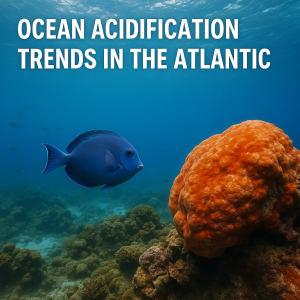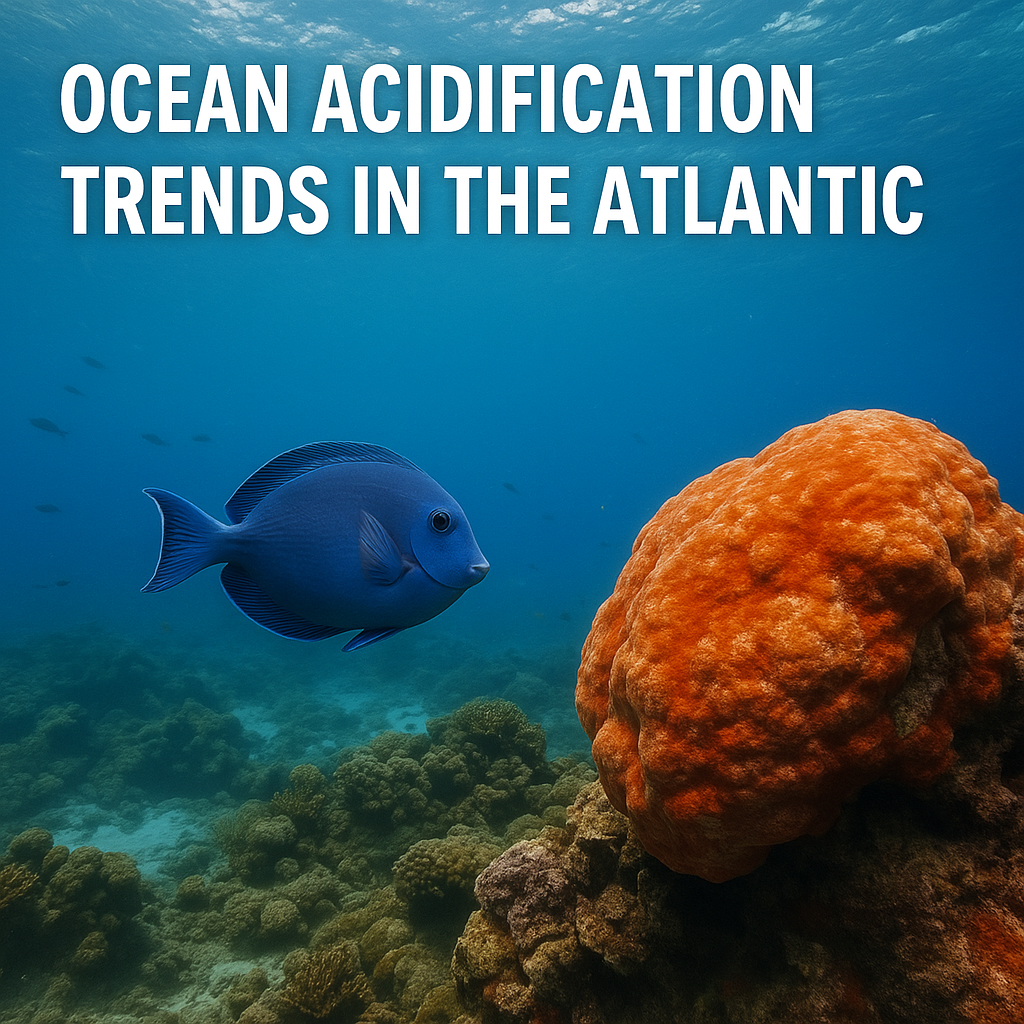Explore the rising concern of ocean acidification in the Atlantic Ocean. Learn what the latest science reveals about the causes, trends, and implications for marine life, shipping, and global climate systems.”
Why Ocean Acidification in the Atlantic Matters
 Imagine a slow, silent erosion of the ocean’s chemistry — one that doesn’t grab headlines like oil spills or melting glaciers but is equally transformative. Ocean acidification is precisely this invisible threat, altering seawater chemistry due to increased absorption of atmospheric CO2. The Atlantic Ocean, a vital artery of global trade and biodiversity, is showing alarming acidification trends. These changes affect everything from coral reefs and plankton to commercial fish stocks and maritime economies.
Imagine a slow, silent erosion of the ocean’s chemistry — one that doesn’t grab headlines like oil spills or melting glaciers but is equally transformative. Ocean acidification is precisely this invisible threat, altering seawater chemistry due to increased absorption of atmospheric CO2. The Atlantic Ocean, a vital artery of global trade and biodiversity, is showing alarming acidification trends. These changes affect everything from coral reefs and plankton to commercial fish stocks and maritime economies.
According to the Intergovernmental Panel on Climate Change (IPCC, 2023) and NOAA, the Atlantic Ocean is absorbing a significant share of global anthropogenic CO2 — making it one of the fastest acidifying ocean basins in the world. These changes aren’t just ecological footnotes; they hold real implications for fisheries, coastal protection, port infrastructure, and international maritime operations.
The Science Behind Ocean Acidification
Ocean acidification occurs when CO2 dissolves into seawater, forming carbonic acid. This weak acid lowers the ocean’s pH and reduces carbonate ion availability — crucial for marine species like shellfish and corals to build their skeletons and shells.
The average ocean pH has dropped from 8.2 to around 8.1 since the industrial revolution — a 25% increase in acidity. In some parts of the North Atlantic, however, particularly along the eastern U.S. coast and near the Arctic gateway, the decrease is more rapid (Marine Pollution Bulletin, 2022).
Carbonate saturation states are also declining, affecting organisms from deep-sea cold-water corals to surface-dwelling pteropods — small, shelled plankton that form the base of many Atlantic food webs.
Key Trends and Scientific Discoveries in the Atlantic
Accelerated Acidification in the North Atlantic
The North Atlantic Subtropical Gyre, stretching between the U.S. East Coast and Europe, shows some of the highest CO2 uptake rates in the global ocean. According to a 2022 study in Deep Sea Research Part II, this region exhibits strong seasonal variability in acidification, especially in surface waters. Winter mixing brings CO2-rich deeper waters to the surface, exacerbating pH changes.
Researchers using Argo floats and satellite altimetry data have confirmed that changes in ocean circulation (especially the slowing of the Atlantic Meridional Overturning Circulation, or AMOC) are influencing acidification distribution (World Ocean Review, 2023).
Coastal Acidification Hotspots
Coastal waters in the western Atlantic — from the Gulf of Maine down to the Mid-Atlantic Bight — are experiencing both anthropogenic and land-derived acidification. Nutrient runoff from agriculture increases CO2 via biological activity and decomposition. According to NOAA’s Northeast Fisheries Science Center, this has led to localized seasonal pH drops below 7.7 in estuaries.
Shellfish hatcheries in New England are already reporting reduced larval survival rates linked to low carbonate saturation.
The Tropical Atlantic and Coral Bleaching
The Caribbean and tropical Atlantic, while warmer and less CO2 soluble than colder regions, are still vulnerable. Coral reefs across the Bahamas, Belize, and northern Brazil are under stress from both warming and acidification. Reduced aragonite saturation (a form of calcium carbonate) affects coral calcification rates and leads to weakened reef structures.
UNESCO’s 2022 Global Coral Reef Monitoring Network report identified the Atlantic’s tropical reefs among the most structurally degraded due to compounding climate impacts.
Deep Atlantic and Cold-Water Coral Risks
Cold-water coral ecosystems like Lophelia pertusa found off the coasts of Ireland, Norway, and Portugal exist in nutrient-rich, but pH-sensitive, waters. Recent research from the Royal Netherlands Institute for Sea Research (2021) found that the saturation horizon (the depth at which carbonate dissolves) is rising — threatening these coral habitats from below.
These ecosystems serve as biodiversity banks and fisheries habitats, making their vulnerability a cross-sectoral concern.
Technological Advancements Supporting Monitoring
To accurately track acidification, global collaborations such as the Global Ocean Acidification Observing Network (GOA-ON) are deploying smart buoys and autonomous platforms in the Atlantic. These tools collect real-time data on pH, alkalinity, temperature, and salinity.
Satellites operated by ESA (European Space Agency) and NOAA now contribute surface data layers, while advanced ship-based sensors (e.g., from the R/V Ronald H. Brown) provide vertical pH profiles.
Shipping companies like Maersk and NYK Line are increasingly installing onboard CO2 sensors through partnerships with IMO-backed decarbonization programs.
Implications for Maritime Stakeholders
Ocean acidification is not just an issue for marine scientists. It’s reshaping the operational environment for:
- Fisheries and Aquaculture: Reduced productivity in shell-forming species like clams, mussels, and scallops is impacting fisheries in Canada and the northeastern U.S. Shell integrity is compromised, leading to economic losses.
- Shipping and Port Infrastructure: Changes in pH can affect the corrosion rates of port materials and ballast water systems. A 2023 report by DNV warns that prolonged acidification may shorten infrastructure lifespan and require adjusted maintenance cycles.
- Climate Modeling and Navigation: Since acidification interacts with temperature, salinity, and currents, it is being incorporated into ocean circulation models used for ship routing and climate forecasting.
- International Policy and Trade: The IMO’s GHG Strategy and MARPOL Annex VI now indirectly consider carbon uptake consequences, and future climate resilience regulations may include ocean chemistry thresholds.
Case Studies: Countries Responding to Acidification
Canada
Fisheries and Oceans Canada (DFO) and the Bedford Institute of Oceanography are leading Atlantic pH monitoring projects. The SmartAtlantic Alliance uses real-time monitoring buoys in places like the Scotian Shelf and Labrador Sea to inform both science and maritime navigation.
Nova Scotia’s aquaculture industry has received provincial funding to adapt hatchery practices to buffering techniques.
Norway
Norwegian waters host cold-water coral ecosystems that are both ecologically and commercially valuable. The Institute of Marine Research (IMR) is working with the IMO and EU agencies to integrate acidification into environmental impact assessments for oil and gas licensing.
Shipping companies are trialling alternative hull coatings to resist increased corrosion risks linked with changing seawater chemistry.
Brazil
Brazil’s coral reef zones — particularly Abrolhos and the Fernando de Noronha archipelago — are vulnerable. The country has partnered with UNESCO and the Coral Restoration Foundation to install monitoring stations that combine pH data with coral bleaching alerts.
Marine reserves in these areas are now trialling “resilience corridors” to link reef zones through marine protected areas (MPAs).
Future Outlook
Looking ahead, acidification in the Atlantic will likely intensify as atmospheric CO2 continues to rise. However, there are reasons for cautious optimism:
- Data Networks: Expanded pH monitoring using smart technologies will make early warnings more precise.
- Policy Integration: The 2023 High Seas Treaty includes mandates for safeguarding marine biodiversity — opening the door to legally binding acidification mitigation targets.
- Shipping Sector Innovations: The maritime industry is investing in biofouling-resistant coatings and non-metallic composites to adapt port structures and ships to low-pH conditions.
- Education and Public Awareness: Campaigns by Hakai Magazine and the World Ocean Network are helping port communities and schools understand acidification’s impact.
FAQ
1. What causes ocean acidification in the Atlantic?
It’s caused primarily by the absorption of excess atmospheric CO2, which reacts with seawater to form carbonic acid, lowering the ocean’s pH.
2. Why is the North Atlantic acidifying faster than other oceans?
It absorbs more CO2 due to cold water temperatures and active vertical mixing. Human-caused runoff in coastal areas adds to the issue.
3. How does acidification affect fish and shellfish?
It reduces carbonate ions needed for shell-building and can affect sensory behavior in fish, impacting feeding and migration.
4. Can ocean acidification damage port infrastructure?
Yes. Acidified waters may accelerate corrosion of metallic structures and challenge the integrity of ballast water systems.
5. Is ocean acidification reversible?
Only if global CO2 emissions are drastically reduced. Natural buffering can take centuries without intervention.
6. How is acidification measured?
Using pH sensors, spectrophotometry, alkalinity tests, and autonomous monitoring systems like Argo floats and buoys.
7. What regulations address this issue?
While no single treaty targets acidification, it’s addressed within broader agreements like the Paris Agreement, MARPOL Annex VI, and regional MPAs.
Conclusion
Ocean acidification in the Atlantic is a defining environmental issue of our time. Though invisible, its effects ripple across ecosystems, industries, and nations. The maritime community — from regulators and shipbuilders to port authorities and educators — must work collaboratively to mitigate risks and adapt proactively. Investing in monitoring, science-based policymaking, and sustainable maritime practices is no longer optional — it’s urgent.
As our oceans become more acidic, our response must become more adaptive, data-driven, and united.
References
- Intergovernmental Panel on Climate Change (IPCC). (2023). Sixth Assessment Report. https://www.ipcc.ch/report/ar6/
- Marine Pollution Bulletin. (2022). Elsevier. https://www.journals.elsevier.com/marine-pollution-bulletin
- World Ocean Review. (2023). https://worldoceanreview.com/
- NOAA Ocean Acidification Program. https://oceanacidification.noaa.gov
- DNV. (2023). Maritime Forecast to 2050. https://www.dnv.com
- Global Ocean Acidification Observing Network. https://www.goa-on.org
- Bedford Institute of Oceanography. https://www.bio.gc.ca
- Royal Netherlands Institute for Sea Research. https://www.nioz.nl/en
- Coral Restoration Foundation. https://www.coralrestoration.org
- UNESCO Global Coral Reef Monitoring Network. https://gcrmn.net/
- European Space Agency (ESA). https://www.esa.int
- MarineTraffic. https://www.marinetraffic.com
- Hakai Magazine. https://hakaimagazine.com
- IMO GHG Strategy and MARPOL Annex VI. https://www.imo.org
- Fisheries and Oceans Canada (DFO). https://www.dfo-mpo.gc.ca
- Institute of Marine Research (Norway). https://www.hi.no/en
- UN High Seas Treaty (2023). https://www.un.org/bbnj

